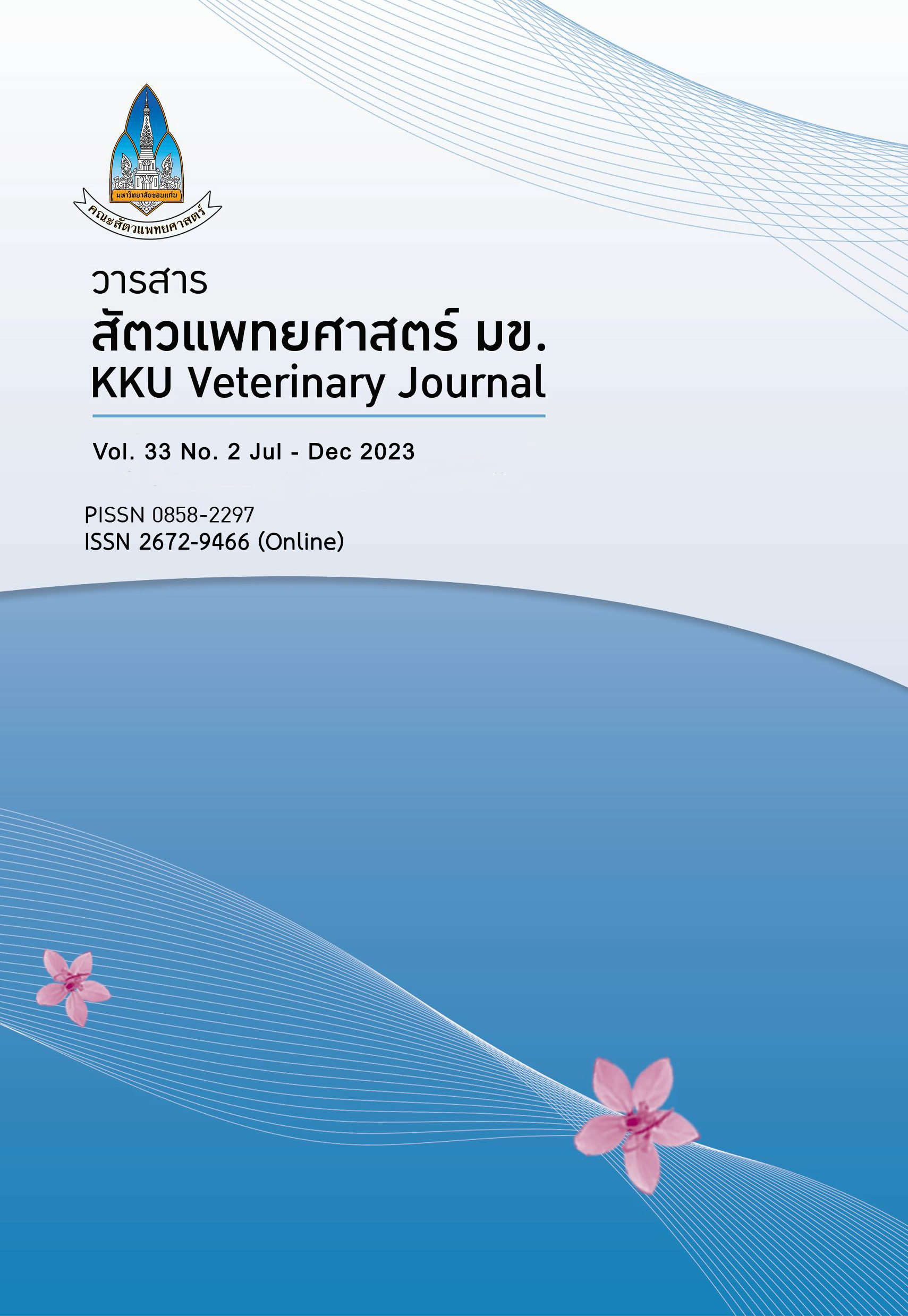Effects of fermented residues from noodle factory in diet on performance and carcass quality in Thai native chicken
Main Article Content
Abstract
Objective: The nutritional value and efficiency of the nutrients in the constituent parts of animal feed can be enhanced by adding fermented noodles factory leftovers as an ingredient. Additionally, to improve the efficiency of handling animal feed and reduce costs for animal farmers.
Materials and methods: A completely randomized design (CRD) was conducted with 200 Thai native chickens of mixed genders. The trial used leftovers from a facility that produced fermented noodles, and it involved 50 hens per treatment, ages 4 to 12 weeks, of varying degrees, to compare the amount of leftovers from fermented noodles factories added to commercial food at all four levels: 0%, 10%, 20%, and 30% of the residue from the fermented noodles factories, respectively.
Results: From this research a feed formula using the leftovers from the fermented noodle factory was discovered to have higher levels of nutrients, particularly in the areas of protein and fat, with 7.23% protein, 4.73% fat, and 48.28% dry matter, respectively, when fed to local hens for a certain amount of time. 4–12 weeks by examining the native chicken's production efficiency in a controlled experiment where the researchers used 10, 20, and 30% of the residue from a fermented noodle factory instead of none at all. The existence of value production efficiency was discovered. There were no statistically significant variations (p≥0.05) in the carcass quality, including initial weight, final mass weight exchange rate (Feed Conversion Ratio; FCR) and body weight changes (Body Weight Gain; BWG). Nevertheless, it was discovered that following the trial, the feed cost per gain (FCG) of the group utilizing leftovers from the fermented noodle factory dropped (p<0.05). The average weight of the hens was determined to be between 956.25 and 975 grams per bird; there was no discernible difference in the weights (p > 0.05). However, there was a change in production costs when the amount of waste from the fermented noodle factory was increased in the experimental diet. The number of native hens dropped dramatically (p<0.05).
Conclusion: Fermented residues from the noodle factory do not affect production efficiency or carcass quality, but the feed cost per gain (FCG) of the group that uses scraps left over from the fermented noodle factory will be reduced. When increasing the level of waste from the fermented noodle factory in the experimental feed, resulted in a reduction in the cost of producing local chicken.
Article Details

This work is licensed under a Creative Commons Attribution-NonCommercial-NoDerivatives 4.0 International License.
References
Adamafio N A, Sakyiamah M, and Tettey, J, 2010. Fermentation in cassava (Manihot esculenta Crantz) pulp juice improves nutritive value of cassava peel. Afr J Biochemis Res 4(3), 51-56.
Al-Madahidi M, Vydelingum V, Lawrence and Saudi J, 2010. Mothers’ Expected Intentions and Attitudes Toward Breast-Feeding. ICAN: Infant Child Adolesc Nutr 2(3), 187-198.
AOAC, 2012. Association of Official Analytical Chemists. 19th ed. Gaithersburg, MD, USA: AOAC International; Official methods of analysis.
Belewu MA, and Babalola FT, 2009. "Nutrient enrichment of waste agricultural residues after solid state fermentation using Rhizopus oligosporus. J Appl Biosci 13, 695-699.
Ezekiel R, Rana G, and Singh N, et al, 2010. Physico-chemical and pasting properties of starch from stored potato tubers. J. Food Sci Technol 47, 195–201.
Norrapoke T, Wannapat M, Cherdthong A, Kang C, Pharmacach K, and Phongjongmit T, 2016. Improving the nutritional value of fermented cassava waste and the in vitro fermentation process by Fermentation of urea and molasses. Kaen Kaset 44 (Special Issue 1), 405-412.
Norrapoke T, Phongjongmit T, Cherdthong A, and Nitiphot P, 2018a. The use of urea together with molasses fermented cassava pulp on the edible amount, digestibility and biochemical values in the blood of beef cattle. Kaen Kaset 46 (Special Issue 1), 25-32.
Phasouk A, Tarachai P, Panatuk J, Chukiatsiri K, Paserakung A, Chompupun K, Somrak P, 2019. A study of growth performances and carcass composition of black-boned chickens between confinement and different pastures of free-range rearing system. Khon Kaen Agriculture Journal 47(Suppl.1), 111-116.
Prapakorn T, 2017. Poultry production. Teaching materials for poultry anatomy and physiology. Department of Animal Science Faculty of Animal Science and Maejo University Technology. Chiang Mai.(Source): http://www.as2.mju.ac.th 6 August 2021 page 166. (In Thai).
Pratchaya P, and Noppawan C, 1995. Raising traditional native-Shanghai hybrid chickens. Annual research report 1995, pp. 15-19, Animal Feed Division, Department of Livestock Development, Bangkok.
Puttaraksa P, 2011. Effect of free-range raising system on growth performance, carcass characteristics and meat quality of Thai native chickens. A Dissertation Submitted in Partial Fulfillment of the Requirements for Master of Science Degree of Educational Studies Suranaree University. (In Thai).
SAS, 2013. User’s guide: Statistic, version 9. 4th ed. Cary, NC: SAS Inst. Inc. Cary, NC, USA.
Warunee P, Chaisaeng P, Somkid P, Sophon C, Chantakarn O and Wiroj R, 2004. Standards for fermented animal feed plants. 1st printing. Bangkok: Agricultural Cooperative Assembly Press Thailand.28 pages.


